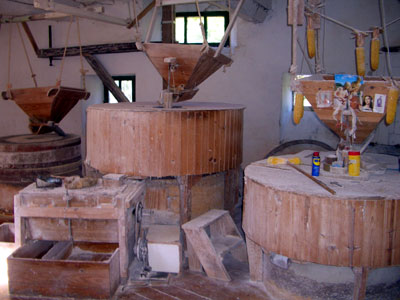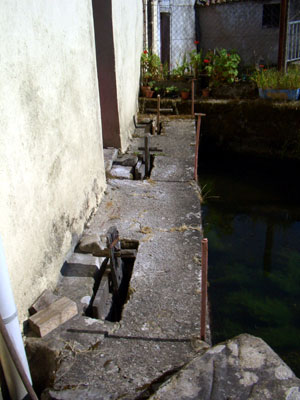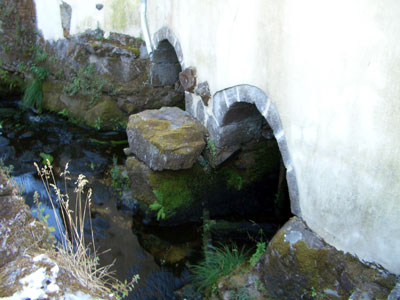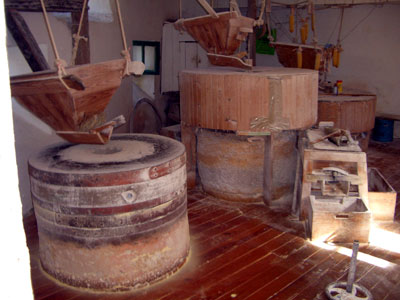Galician watermills, Noia
Please note, this mill is privately owned and is not open to the public. We were very fortunate to be given the opportunity of a tour by the owner who was a friend of a friend.
Like many parts of the world, flour was originally produced in Galicia by using water power
 to turn large circular grinding stones against one another with the grain being ground between them.
to turn large circular grinding stones against one another with the grain being ground between them.
The propensity of rivers and streams in Galicia has always made this method accessible and the power of harnessing running water was a main stay of the region's many communities.
These mills did at one time produce significant quantities of finely ground grains and they were the lynch pin of any town's economy. Only a few decades ago even the smallest village had a least one watermill, but today few remain and most of those that do are now visitor centres or museums.
Above right, the grinding stones inside the mill, along with assorted components used in the milling process.
The watermill at Noia
Whilst in the town of Noia we noticed that the local tourist guide mentioned the existence of
 a "still working" watermill and we decided to try and find it.
a "still working" watermill and we decided to try and find it.
In keeping with many of Galicia's tourist promoted exhibits, when we eventually tracked the mill down it was privately owned and unavailable for public access.
However, whilst talking to a neighbour of the owner we discovered that there was a family connection to my wife. As ever in Galicia this resulted in our being enthusiastically ushered into the mill and given a tour and demonstration.
Left, I believe that these are called the sluce gates and they open and close the water flow in and out of the mill and its machinery.
The pictures explain better than words how things actually work, but put simply, sluice
 gates direct the water through a channel where it turns a wheel which in turn causes the stones to grind. The grain is poured through the top stone where upon it is crushed to the required fineness. The gauge of the grain can be controlled and adjusted, as can the speed of the grinding wheels.
gates direct the water through a channel where it turns a wheel which in turn causes the stones to grind. The grain is poured through the top stone where upon it is crushed to the required fineness. The gauge of the grain can be controlled and adjusted, as can the speed of the grinding wheels.
In days gone by, these small mills literally worked around the clock and were used by all the farmers and small holders of the area. Today few remain and most of those that do have fallen into rack and ruin.
Right, These are channels or culverts that allow the flow of water once the gates have been opened.
The area next to the mill also had one of the traditional Galician washing stalls fed by diverted water from the river. It was obvious that this small area was once a commercial and
 cultural hub where food processing, the washing of clothes and plenty of social interaction took place.
cultural hub where food processing, the washing of clothes and plenty of social interaction took place.
Even as we looked around in 2006, some of the town's older generation were still washing and drying their clothes there, just as they had done a hundred years earlier.
A final picture taken inside the small mill in Noia. Today this mill is used periodically, but everything still works and those who buy the flour say that it is of superior quality to that bought in a shop.

